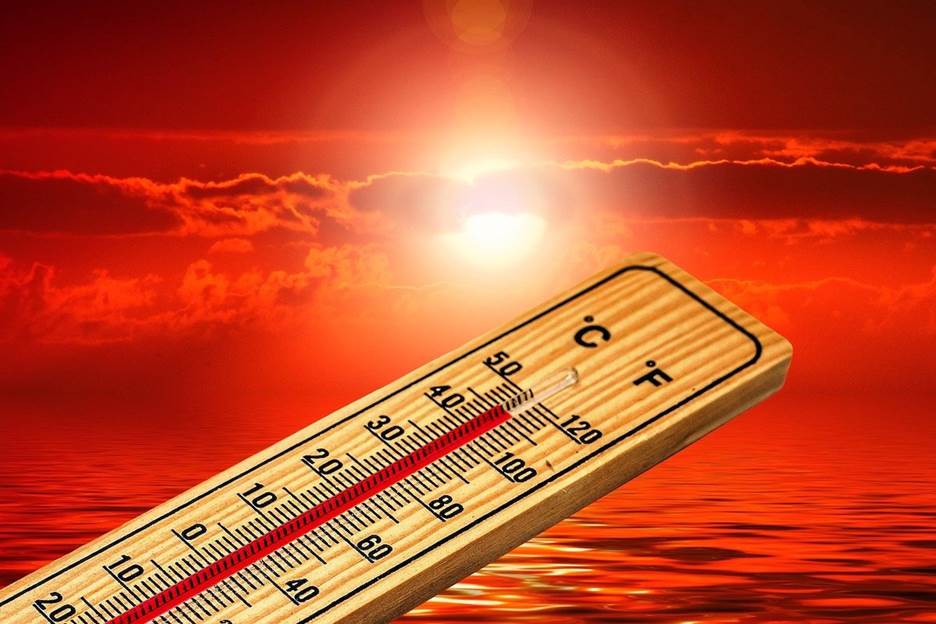
As heat-related illnesses and deaths have risen in Imperial County over the past few years, cooling centers prove critical in the fight against extreme heat - Español
How California’s Hottest and Most Latino County Is Fighting Extreme Heat
By Selen Ozturk
This past week saw the hottest global temperature ever recorded, according to the US National Centers for Environmental Prediction. But while extreme heat hits ever-new regions of the United States, in Imperial County it remains par for the course.
The region, located on California’s southeast border, faces temperatures averaging over 100 degrees Fahrenheit for months in the summer. It’s over 6 degrees warmer on average than any other county in the state.
Extreme heat — which the Environmental Protection Agency has deemed “the leading weather-related killer in the United States” — is defined for most of the United States as at least two to three days of high heat and humidity with temperatures above 90 degrees . In Imperial County, however, these conditions are far from abnormal; some areas faced over 117 days of triple-digit weather last year.
Despite these record-melting conditions, the county remains underserved. Over a fifth of its 180,000 residents live in poverty, while a third live without air conditioning. It’s also the state’s most Latino county, with over 85% of the population identifying as such (or as Hispanic).
Expanding cooling centers
Esperanza Colio Warren, manager of the border city of Calexico, has been at the front lines of those working at the local government level to help these residents survive extreme heat. Central to this effort has been the expansion of cooling centers throughout the county.
For 18 years before her current job, she was a grant writer — and, later, deputy CEO — for the Imperial County Department of Community and Economic Development. During this time, she funded the three fire station cooling centers in the county, in the towns of Niland, Winterhaven and Seeley.
These centers are in state-designated colonias : rural border communities with high poverty, inadequate facilities (particularly water and sewer infrastructure), and scarce housing beyond modular or trailer homes.
“When homes in these areas are badly insulated, or the AC or power breaks down,” said Warren, “these families previously had nowhere safe to go. These cooling centers are not only a refuge from the heat but a community meeting place where residents of these isolated, sparsely populated areas can mingle. They’re open from 8 a.m. to 8 p.m. during high summer heat, when even in the evening July temperatures can exceed 100 degrees.”
Under Warren, Imperial County was the most successful in California; in 2018, 98% of its grant proposals were obtained.
Competing for state funds
This success was hard-won: any county with less than 200,000 people and any city with less than 50,000 people must compete for state funds rather than receiving a set allocation, which are acquired through the US Department of Housing and Urban Development. As of July 2022, the US Census population estimate for Imperial County was under 180,000, while the estimate for its most populous city, El Centro, was under 44,000.
According to Warren, grant writers in Imperial County often compete with 176 other jurisdictions for approximately $30M to $40M in each annual cycle. During her tenure, her proposals for all three cooling centers — ranging from $3M to $5M — were funded.
“As a more competitive selling point, we applied to build fire stations with cooling centers as part of this facility. The process generally takes three years from the application to the contract bidding stage,” she said.
Minimizing heat related deaths
Despite these measures, extreme heat-related illnesses and deaths have been rising in the county. Last year, 283 heat-related illnesses were reported by local hospitals — a 15% increase from 2021 and a 12.7% increase from 2019 (reports weren’t published in 2020 due to the pandemic). Local hospitals and the County Coroner’s Office also reported 27 confirmed or probable heat-related deaths in 2022 — a 17.4% increase from 2021, and a 440% increase from 2019.
Jorge Torres, Program Supervisor for the Imperial County Public Health Department, said that much of these increases are due to pandemic-related restrictions.
“As we needed to take more precautions during the pandemic, we saw staffing numbers fall and cooling sites close,” he explained. “Last year, the County made more hydration stations available by reaching out to local nonprofits about water donations. This year, as we expand cooling centers and extreme heat communications, we expect to see heat-related illnesses and deaths fall. Minimizing them is our number-one priority in fighting extreme heat.”
Including those available as part of local facilities like libraries and city halls, nine cooling centers and thirteen hydration stations will be available throughout Imperial County this summer , spanning a total of seventeen sites.
“As summer progresses,” added Torres, “we’ll be publishing messages for the community on our website and throughout our social media, including heatwave and heat emergency declarations, cooling center and hydration station updates, and tips for staying cool and hydrated. We want options available for the residents of Imperial County before they’re needed.”
Related: Statewide Summer Safety – Know the Risks and Have a Plan – Ethnic Media Services

